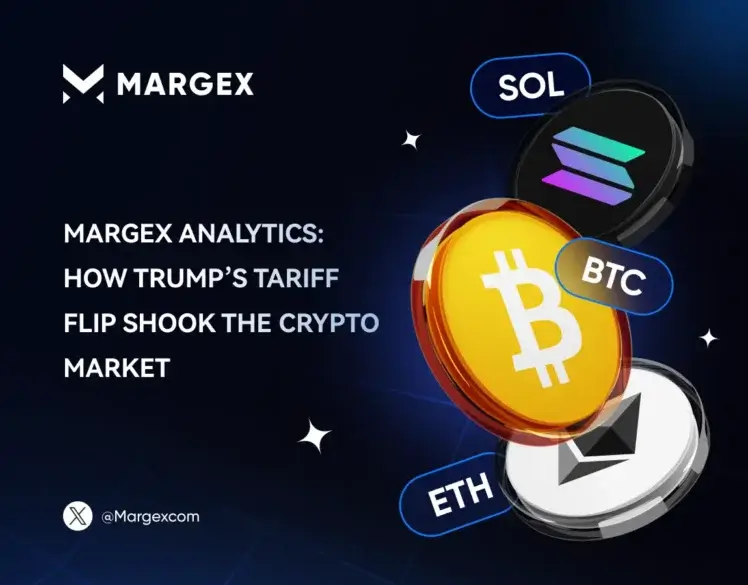How Trump’s Tariff Flip Shook the Crypto Market

From April 7 to April 14, 2025, the cryptocurrency market was volatile as its price fluctuated due to macroeconomic shocks, regulators’ intervention, and numerous other reasons. Major cryptocurrencies, like BTC, ETH, SOL, XRP, and many others, were influenced by US tariff policies, political developments, and industry-related news and saw dramatic price swings. In this recap, they cover the biggest market-moving events of the week and how they affected both the market and the price action of notable digital assets.
U.S. Tariff War Triggers Market Decay
Then, on April 5, 2025, the сrypto market felt a sharp downturn as U.S. President Donald Trump’s administration placed a 10% tariff on all the countries, effective April 7. This was a risky off-move, plunging global markets into a fear of a trade war, and would seem to bear upon cryptocurrencies the brunt of such worries.
During intense selling pressure, the total market capitalization of cryptocurrencies decreased a whopping 13 percent on April 5 to an intraday low of $2.31 trillion. In the same span of 24 hours, the OKX figure liquidated over 460,996 traders, and a single BTC/USD swap liquidation on OKX totaled $7 million.
- According to Reuters on April 7, Bitcoin (BTC) plunged to a 2025 Wednesday low of $74,434 in Bitstamp, with a 5.5% loss for the day. This marked a significant retreat from its earlier resilience above $80,000.
- Ethereum (ETH) extended its three-day losses to reach $1,400 on April 7, with the price dropping 16 percent over 24 hours.
- Other Notable Cryptos: Speculative altcoins followed suit, with both large and small altcoins taking a hit with widespread liquidations.
- Despite early in the week being set with a bearish tone from the tariff-induced panic, crypto remained sensitive to macroeconomic policies.
Trump’s Tariff Pause Sparks Crypto Rally
On April 9, midweek, President Trump dangled a 90-day suspension of tariffs to countries that had not retaliated against the U.S. in full market-relief rally mode. According to Bloomberg, Bitcoin rallied 7.7 percent to $82,967, and smaller cryptocurrencies rose further. When Trump tweeted that this policy reversal, which was released through his social media platform, restored confidence, the crypto price movements followed the gains in U.S. equities, with the Nasdaq and S&P 500 gaining 7 percent and 8.8 percent, respectively.
Next day, CNBC reported that Bitcoin (BTC) bounced back from a weekly low, crossing the $82,305.55 mark, or a 7% increase. As of April 10, it was $83,200 up from the pre-announcement price of $78,000 according to Investopedia.
- Ethereum (ETH) gained more than 12%, rebounding to above $1,600.
- Strong altcoin momentum meant SOL soaring more than 14%.
- XRP and DOGE: Both bettered 12%, but XRP was helped by the potential of positive regulation.
- Coinbase jumped 17%, Strategy reached 23%, and MARA Holdings skyrocketed.
- Bitcoin and altcoins’ recovery from this was primarily an affirmation of the market’s reactivity to Trump’s policy changes in the past.
Binance Faces Regulatory Scrutiny and Delisting Drama
In two weeks, Binance, the world’s largest crypto exchange, made the headlines twice. Reuters reported first on April 11 that Binance executives met U.S. Treasury officials to talk about fiddling with oversight and eventually agreeing to deal with Trump’s cryptocurrency venture – World Liberty Financial. The concerns about regulatory favoritism were heightened in light of Trump’s pro-crypto persona. Second, Binance pledged to delist 14 tokens, including BADGER, Balancer (BAL), and Cream Finance (CREAM), at the community’s decision on April 16. This move was noted by FXStreet as part of Binance’s periodic portfolio cleanup, which affected smaller altcoins’ liquidity.
Trump Signs Bill to Ease Crypto Broker Rules
President Trump signed a bill on April 10, overturning an IRS rule that had made decentralized exchanges similar to crypto brokers, as reported by Reuters. The move, cheered on by the industry, eased burdens on reporting to DeFi platforms in adherence with Trump’s campaign promise to foster crypto innovation. This increased sentiment among the sector as the White House statement emphasized supporting the growth of the blockchain.
- On April 11, Bitcoin (BTC) followed suit with an edge higher to $84,000, thanks to the regulatory relief driving bullish sentiment.
- Gold value rose to $1,650 due to the popularity of DeFi in the Ethereum ecosystem.
- Post news, SOL rises 5%, other Defi tokens like Uniswap (UNI) and Aave (AAVE) also gained 3–7 percent as a sign of optimism for decentralized systems.
- The crypto advocates were happy with the bill’s passage and suggested the U.S. as a potential hub for blockchain innovation.
Justice Department Shifts Crypto Enforcement Focus
On April 7, The Washington Post reported that the U.S. Justice Department was disbanding the National Cryptocurrency Enforcement Team. Deputy Attorney General Todd Blanche announced a major policy shift. Thus, the department will turn its attention to crimes committed while the parties are involved with cryptocurrencies, such as fraud and trafficking, not to the cases that better fit into the domain of financial regulators. At the time, the move helped Trump with his deregulatory agenda but raised questions about investor protections.
- Bitcoin (BTC): Dipped slightly to $79,500 on April 8 amid uncertainty but recovered post-tariff pause.
- ETH and Ethereum Altcoins (ETH) showed moderate volatility; ETH stayed above $1,500 and Altcoins including XRP and Cardano (ADA) responded differently.
- The enforcement pivot could have encouraged institutional participation but without much oversight over the risks.
Bitcoin Price Predictions Gain Traction
During the week’s volatility, analysts made bullish forecasts on Bitcoin. BTC could fall between $83,817.03 to $126,061.80 in April 2025, and the average would be $104,939.42. This would bring the 2025 ceiling price to $170,000, influenced by institutional adoption and regulation. Cardano founder Charles Hoskinson believes Bitcoin could reach $250,000 before the year’s end because of stablecoin legislation and big tech involvement.
- Strong recovery momentum among Bitcoin (BTC) recovered to $83,000 by April 12, 12.82 percent up for the week.
- Cardano (ADA) increased 5% to $0.45 after Hoskinson’s comments and the mood of the market.
- Speculation regarding Magnificent 7 (i.e Apple, Microsoft) adoption of stablecoins boosted the interest while there was no direct price impact.
- Retail investor enthusiasm was fed by these predictions and helped Bitcoin remain stable in the late week.
Crypto Assets Soar Post-Tariff Pause
In the case of crypto-related stocks, after Trump nodded down on tariffs, they echoed the recovery of digital assets. On April 9–10, MicroStrategy (Strategy) rose 25%, Coinbase gained 17%, and Robinhood advanced 24%, as Investopedia reported. Bitcoin’s ascent to over $82,000 alongside a regulatory boost gave investors renewed confidence in crypto infrastructure firms, so rallying means.
- Bitcoin: Indirectly benefited over $83,000 from stock gains, suggesting strength in the broader market.
- Ethereum (ETH): Stabilized near $1,600, with ETH-based platforms like Coinbase driving sentiment.
- Solana (SOL) and XRP: The same as above for SOL which hit $150 by April 12 and XRP close to $0.60.
- It also marks a new level of crypto’s inclusion in conventional finance by amplifying price recoveries after the rally.
World Liberty Financial Unveils Stablecoin
The New York Times revealed that on April 11, Trump and his sons launched a stablecoin called World Liberty Financial. By moving this way, Trump has strengthened ties to the crypto industry despite his administration’s regulatory role, sparking questions on how he can avoid a conflict of interest. Its goal was to compete with USDT and USDC for DeFi and cross-border payments.
- Stablecoins (USDT, USDC): Unaffected, maintaining $1 pegs despite competitive pressure.
- On April 12, Bitcoin (BTC) and Ethereum (ETH) saw modest gains with Bitcoin (BTC) at $84,000 and Ethereum (ETH) at $1,650 as stable news strengthens the industry.
- AAVE and UNI rose 4-6% as the interest in stablecoin-driven DeFi applications increased.
- A political takeaway was evident in the crypto launch itself, but the effects on the market were more limited than positive.
Market Outlook and Technical Analysis
After posting a market cap of $2.6 trillion by April 14, the crypto market cap was strong enough by April 8 to reach this level again, up from $2.53 trillion. If the bearish sentiment continued, Bitcoin would drop to $73,000, technical analysis of the currency said, while it was testing resistance between $88,000 and $93,000. But late 2025 gains, fuelled by the global adoption and U.S. policy shift were recommended to be part of the dollar cost averaging (DCA) strategies.
- Bitcoin (BTC) closed the week at $84,000, from $80,000 on April 8. Bitcoin has some resilience, which ends at $1,650, after a rebound from its $1,400 low.
- The altcoin momentum resulted in SOL price reaching $152, XRP to $0.61, and DOGE to $0.14.
- ADA held $0.46, BNB held $605. However, that trend was stopped dead in its tracks after a rather bearish week ended on a cautiously optimistic note.

Conclusion
This week was volatile, and continuous market recovery in crypto. Initial sell-offs follow Trump’s tariff policies only for a rally to follow their partial pause. The world was excited by Binance’s talks, IRS rule changes and Justice Department shifts, and World Liberty Financial’s stablecoin launch. Bitcoin was followed by price recoveries from other coins, including Ethereum, Solana, XR,P and more. Whilst the market sits back and waits for macroeconomic and political currents to navigate, investors keep one eye on breakout signals – and bullish 2025 forecasts. Start your crypto journey with Margex.


